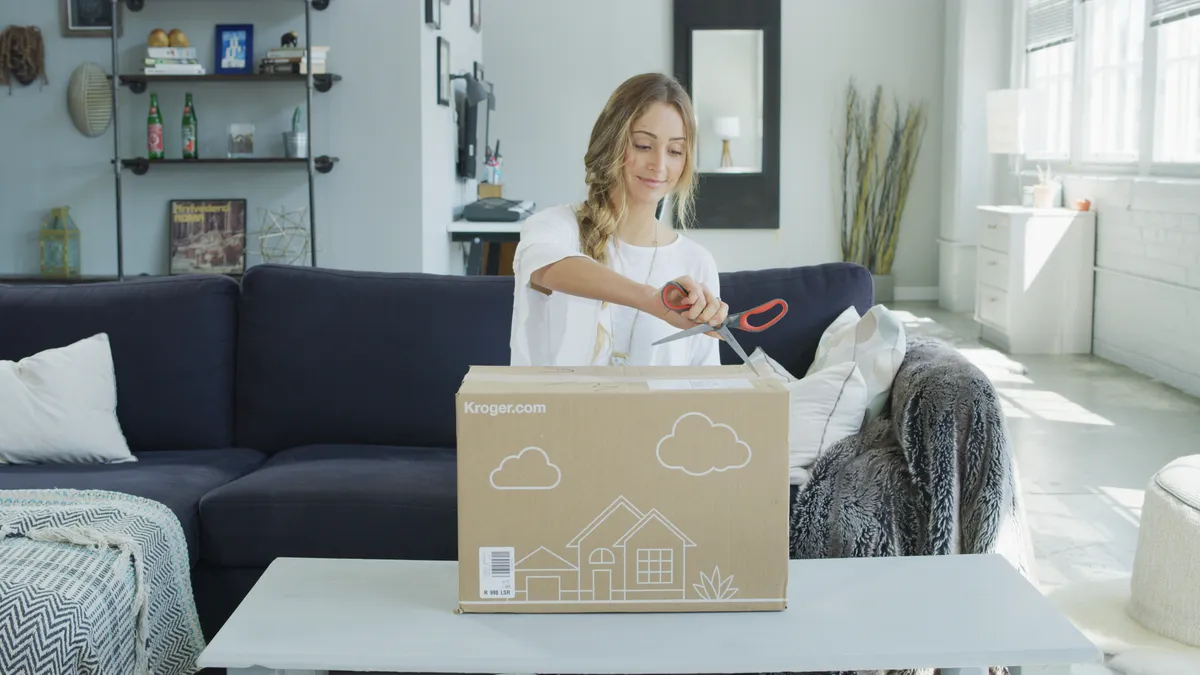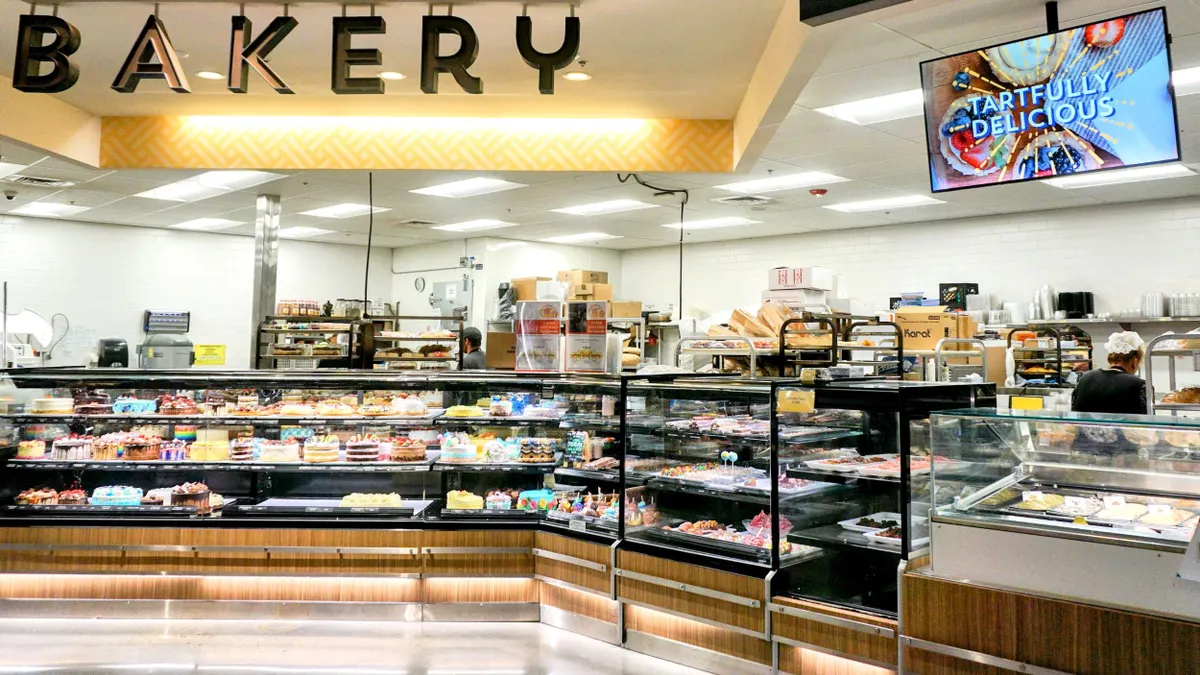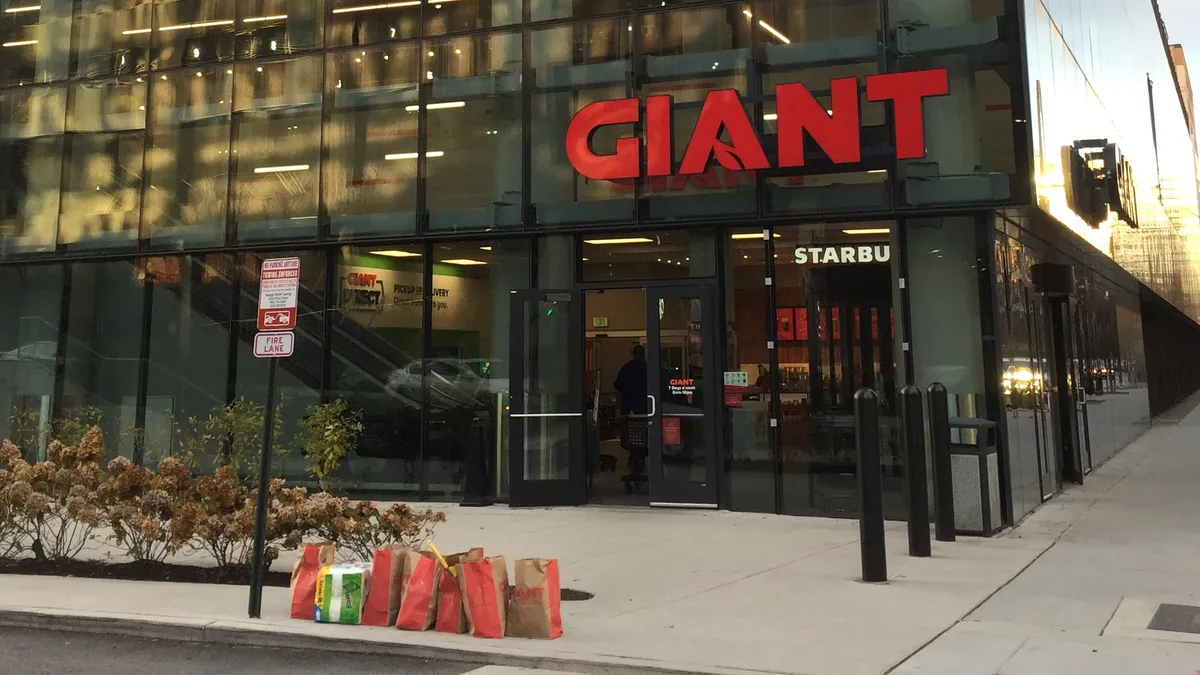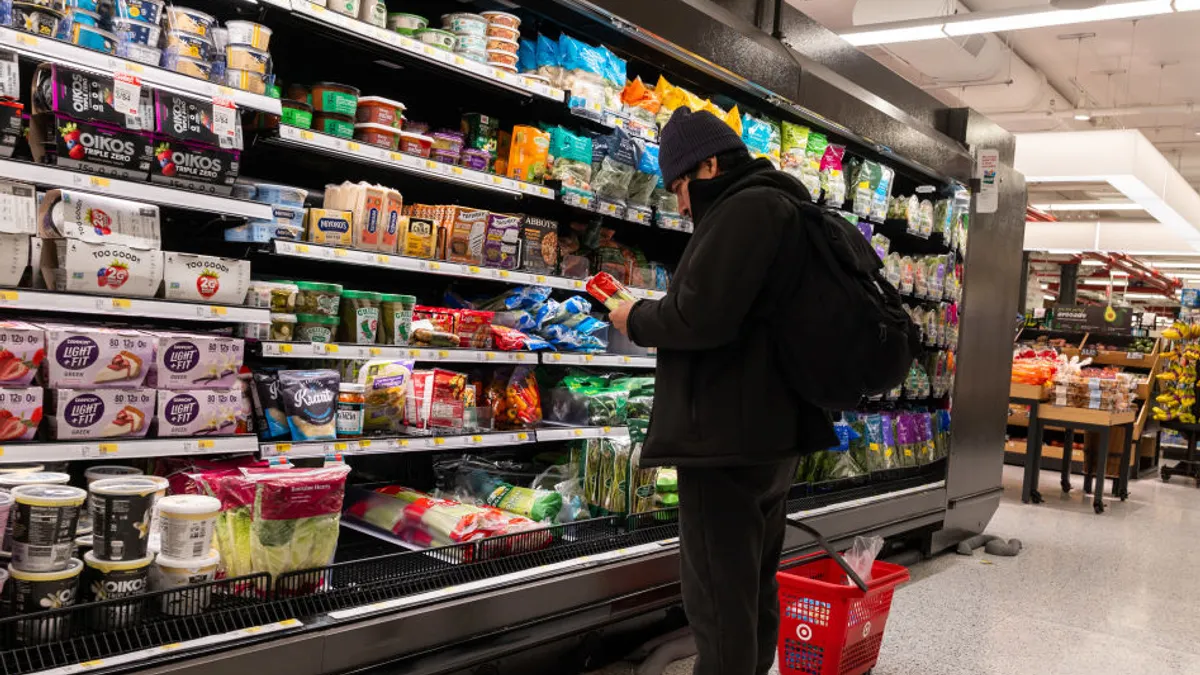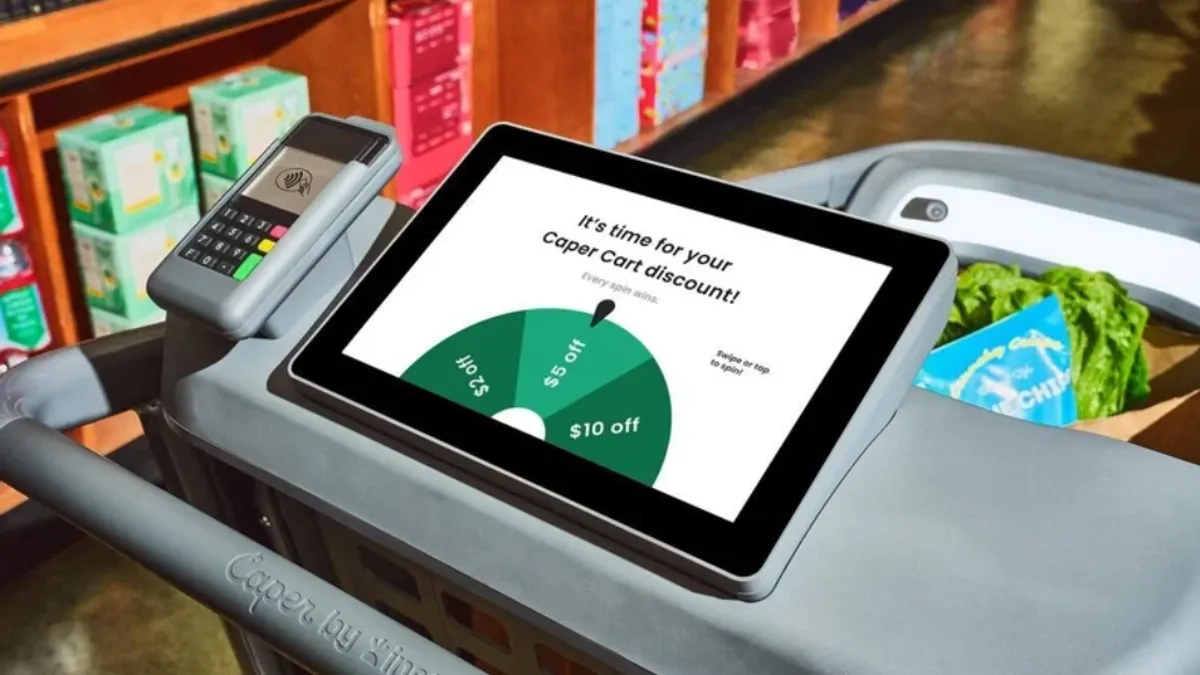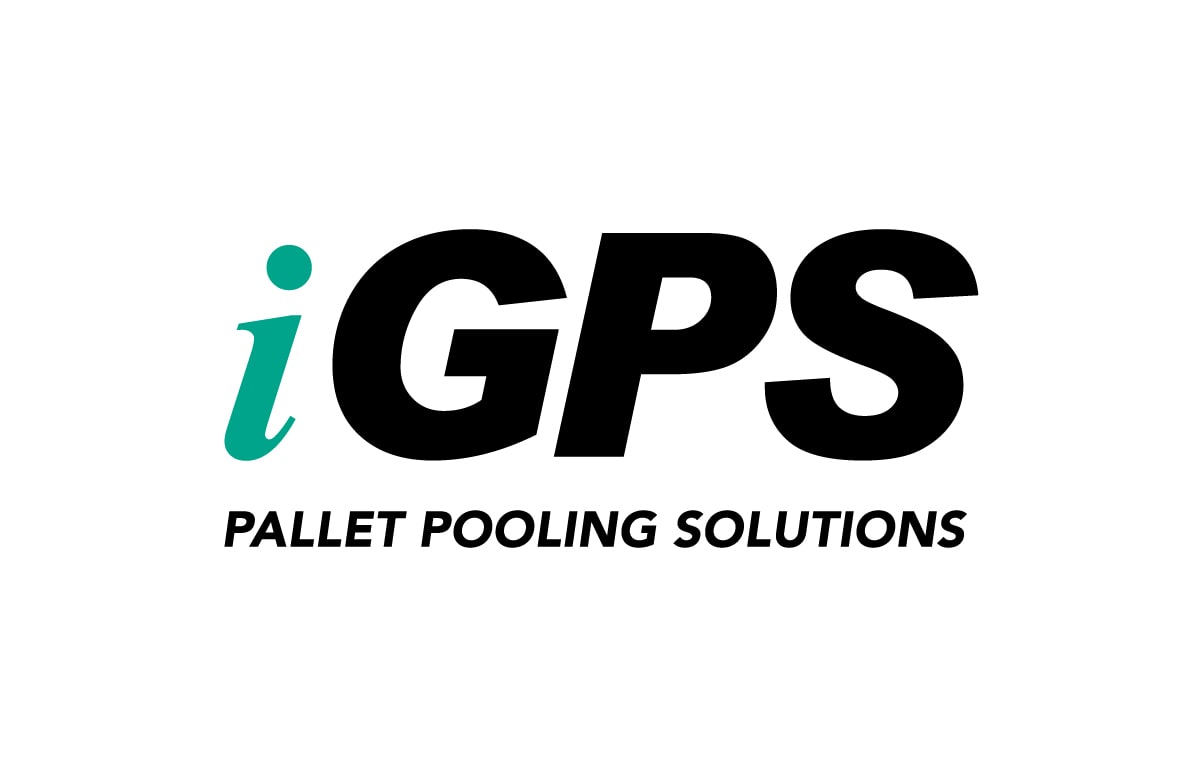This article is part of an ongoing series exploring the future of grocery e-commerce. Next week, Grocery Dive will look at the future of pickup. The full series will be posted here.
As online grocery shopping has swelled over the past few months, so has consumer demand for selection and convenience. As retailers examine how to evolve their online platforms and secure consumer loyalty, many are weighing the merits of a digital marketplace strategy that promises endless aisles of products not found on store shelves.
Adrien Nussenbaum, CEO and co-founder of Mirakl, a software company that has built marketplaces for companies like Best Buy and Carrefour, said his company is working with multiple grocers on marketplace platforms due to roll out in the near future. In August, Kroger rolled out a marketplace strategy with Mirakl as part of its ship-to-home platform, offering more than 50,000 products from third-party sellers, including specialty food items and toys.
Being able to offer an extra bounty of products without having to build out pricey back-end infrastructure sounds like a win for consumers, and it opens the door for retailers to collect additional revenue and shopper data, industry experts say. While Amazon has set the bar for marketplace expectations, retailers in the apparel, electronics and home goods industries have successfully established marketplaces in recent years, seemingly paving the way for grocers to do the same.
But some question the value of a marketplace strategy for grocers. They point out that while Amazon and Walmart have had success with their marketplaces, that doesn't mean competitors should follow suit. There's also little evidence that marketplaces add value for retailers, said Juozas Kaziukenas, founder of Marketplace Pulse, a firm that collects data on retail marketplaces,
"[Kroger’s] biggest differentiation from anyone else, especially Amazon, is the store. Trying to be like Amazon is probably chasing their own tail," he noted.
A new digital tool for grocers
The move into a third-party marketplace isn’t anything new among retailers, with many in the U.S. like Walmart, Urban Outfitters and Dick's Sporting Goods having tried the same approach in an attempt to provide a vast assortment on par with Amazon. It’s less common among grocery retailers, with just a couple recent examples.
Albertsons launched a third-party marketplace in 2018 for hard-to-find natural and organic items, with the goal of expanding it to include up to 100,000 items. As of now, the project is on hold, and Albertsons did not respond to Grocery Dive's request for comment and further details on the platform's future.
"Please stay tuned for a new and improved Marketplace experience in the near future," the website for Albertsons Marketplace reads.
Last November, Canadian supermarket Loblaw expanded into an online marketplace with non-traditional grocery items like baby gear, home goods, furniture and pet products. Like Kroger, Loblaw noted that while its assortment was expanding, the new selections would be "curated" to complement existing products and shopper preferences.
"For example, as new parents prepare for a baby with diapers and formula, they would probably find it very convenient to be able to order blankets, wash cloths or even a crib through us," Hesham Fahmy, vice president for Loblaw Digital said in a statement at the time.
Experts say the pace could pick up for grocers moving into marketplaces. Tory Gundelach, senior vice president of retail insights with Kantar Consulting, said more retailers want marketplaces because they get a dual benefit of expanding the assortment for their shoppers without having to take on the risk to their balance sheet. She sees marketplaces appealing mainly to large and mid-tier grocers that have the resources and customer base to support them.
"It's part of the total evolution of what's happening in grocery."

Brendan Witcher
Principal analyst for digital business strategy, Forrester
Nussenbaum said Mirakl has signed agreements with several companies, and expects to announce them in the coming months.
"We're definitely seeing interest from everyone," Nussenbaum said.
The question for Brendan Witcher, principal analyst for digital business strategy at Forrester, is why more grocers haven’t pursued this strategy already. Given the influx of consumers now shopping online and the high expectations for product discovery and availability, there is a natural business case for a grocer to give customers whatever they want, whenever they want it.
"It’s part of the total evolution of what’s happening in grocery," Witcher said.
Evaluating Kroger's marketplace
Gundelach said Kroger has always been at the forefront of adding alternative revenue streams, and the marketplace is part of the ecosystem the company is building to make a profit beyond physical goods.
In addition to charging commissions to the third-party sellers, which is standard in a marketplace, Gundelach thinks it will be interesting to see how Kroger will use its media business to connect its marketplace to various media platforms and generate additional revenue.
"That’s where you start to think, OK there could be some interesting, more material things that come out of this," she said.
Other analysts aren’t sold on Kroger’s entry into the marketplace space. Kaziukenas said that based on size alone, the initiative leaves him with questions. Kaziukenas analyzes marketplaces including Amazon, Walmart and Target, and he said 50,000 is a very small number of products to offer.
Though Kroger has said that number is a jumping off point that will double its ship-to-home assortment, Kaziukenas thinks it will be important for the company to expand quickly if it wants to succeed in terms of both suppliers and product count.
"A marketplace is great when it provides a vast selection of products," Kaziukenas said.
Amazon, he noted, adds thousands of sellers a day. He also pointed to Walmart as one retailer that has done well with its marketplace. About 90% of the products on Walmart.com come from Walmart's marketplace, with the retailer providing the rest, he said. Walmart also adds a couple thousand new sellers per month and sees a lot of success with brand names.
At the same time, retailer's must take a focused approach to building their marketplaces, noted Nussenbaum, adding products and categories selected by carefully mining customer data. This is especially important at launch, when companies are looking to establish buying habits.
"If you don't open it on the right categories, if you don't invest in making the marketplace part of the experience, if you don't recruit enough sellers, your marketplace will fail," Nussenbaum said.
Kroger's group vice president of product experience, Jody Kalmbach, said the company is taking a "food first" approach to its marketplace and curating the selection in a thoughtful way. Shoppers can find an expanded selection of natural, organic and specialty foods, as well as additional categories like housewares and home products.
Do marketplaces benefit shoppers?
Before a retailer adds assortment through a marketplace, they need to make sure there's enough demand to sustain the model and support its numerous supplier relationships, Kaziukenas said. If third-party sellers don't sell enough products, they may balk at commission fees or pull out of the arrangement altogether.
"That’s the secret magic of marketplaces, where just the fact that someone adds more products to the assortment doesn’t mean there are customers looking for those products," he said.
In Kroger's case, Deb Gabor, CEO of Sol Marketing and author of "Irrational Loyalty," said it's important the grocer aggressively promotes the service and offers clarity to customers on what they gain from it.
"What is the 'Krogerness' of this marketplace? That is unclear to me," Gabor said. "Why, from a consumer perspective should I trust and engage with Kroger on a marketplace like this?"
Kaziukenas said historically, he hasn't seen retailer-launched marketplaces drive significant growth. For Kroger, he said, the greater benefit to its shoppers and its bottom line is to stay focused on digitizing its stores and improving store delivery and pickup.
Kalmbach said Kroger will use its data-mining capabilities to personalize offers for marketplace customers and promote new product discovery. Kroger's marketplace expansion is part of developing a cross-channel, seamless experience, she said. The company has been gathering insights and data to better understand how customers want to shop, and based on the findings, people are looking for different options at different times.
"If you don't open it on the right categories, if you don't invest in making the marketplace part of the experience, if you don't recruit enough sellers, your marketplace will fail."

Adrian Nussenbaum
CEO, Mirakl
An additional challenge for Kroger, and for any retailer, in launching a marketplace is the loss of control the platform can bring for its consumer-facing brand. Gundelach noted the scrutiny Amazon has faced with quality control, while Gabor highlighted issues around broken or defective goods and problems with returns.
"While we don’t know a ton of detail about how Kroger is planning to operationalize this, anytime you’re working in a third-party marketplace, you open yourself up to some of those risks," Gundelach said.
Gabor also said marketplaces are dangerous from a brand perspective. A retailer's name may be on the marketplace, but they won’t have complete control over the customer experience.
"That would be one of the things I might be concerned about if I were Kroger or more importantly, if I was a Kroger consumer," Gabor said.
Kalmbach said Kroger has measures in place to ensure transparency within its marketplace. When customers view products in the marketplace, the third-party seller will be clearly listed, and there will be profiles that show the performance of the seller. Additionally, Kroger holds its sellers to a set of standards, and if not met, they won't be allowed on the platform.
"Transparency around who you are purchasing from is critical," Kalmbach said.
Kaziukenas noted that marketplaces can cause confusion among consumers since they have two experiences — one directly with the retailer and one through its marketplace. Without proper messaging as to how it works, where customers can get their merchandise and whether they can return it in store, customers may be unsatisfied or uncertain about how it all works together.
Kroger's ship-to-home site explains on the main page how the service works and what categories it includes. It emphasizes new product discovery with messaging like, "Explore more new finds," along with links to categories like home goods and toys. With another click, the site connects consumers to its pickup, delivery and store services, reinforcing the Kroger shopping ecosystem.
According to Kaziukenas, it’s going to take time for Kroger’s marketplace to mature. From setting up the technology to acquiring merchants and messaging it to customers, there’s a lot of work ahead. From the outside, Kaziukenas said, creating a marketplace looks simple, but there’s a lot more to it than just launching and trying to compete with Amazon or Walmart.
"That’s just step No. 1," he said.
Jeff Wells contributed reporting to this story



